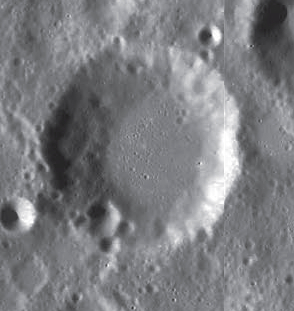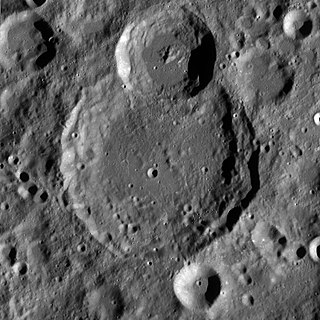
Eratosthenes crater is a relatively deep lunar impact crater that lies on the boundary between the Mare Imbrium and Sinus Aestuum mare regions. It forms the western terminus of the Montes Apenninus mountain range. It is named after ancient Greek astronomer Eratosthenes of Cyrene, who estimated the circumference of the Earth, and the distance from the Earth to the Sun.

Messier is a relatively young lunar impact crater located on the Mare Fecunditatis. The crater has a discernible oblong shape that is not caused by foreshortening. The longer dimension is oriented in an east–west direction.

Dawes is a lunar impact crater located in the wide straight between Mare Serenitatis and Mare Tranquilitatis. To its southwest lies the larger crater Plinius, and to its northeast sits the Mons Argaeus mountain rise. It is named after British astronomer William Rutter Dawes.

Posidonius is a lunar impact crater that is located on the north-eastern edge of Mare Serenitatis, to the south of Lacus Somniorum. It was named after ancient Greek philosopher and geographer Posidonius of Apamea. The crater Chacornac is attached to the southeast rim, and to the north is Daniell.

Moltke is a lunar impact crater near the southern edge of the Mare Tranquillitatis. It is a small, bowl-shaped crater surrounded by a bright halo of higher-albedo material. Just to the south lies the rille system named Rimae Hypatia. These follow a course running roughly east-southeast to west-northwest, and have a length of approximately 180 kilometers.

Plato is a lava-filled lunar impact crater on the Moon. Its diameter is 101 km. It was named after ancient Greek philosopher Plato. It is located on the northeastern shore of the Mare Imbrium, at the western extremity of the Montes Alpes mountain range. In the mare to the south are several rises collectively named the Montes Teneriffe. To the north lies the wide stretch of the Mare Frigoris. East of the crater, among the Montes Alpes, are several rilles collectively named the Rimae Plato.

Aitken is a large lunar impact crater that lies on the far side of the Moon, named for Robert Grant Aitken, an American astronomer specializing in binary stellar systems. It is located to the southeast of the crater Heaviside, and north of the unusual formation Van de Graaff. Attached to the southwest rim is Vertregt. To the southeast is the smaller Bergstrand.

Deslandres is the heavily worn and distorted remains of a lunar impact crater. It is located to the southeast of the Mare Nubium, in the rugged southern highlands of the Moon. In dimension it is the third-largest crater formation on the visible Moon, being beaten only by Clavius and by the 303-kilometer-diameter walled plain Bailly. The northern and eastern parts of the floor display a relatively level surface, but it is pock-marked with numerous craters. There is a small region of mare material, due to basaltic lava, along the eastern interior floor.

Antoniadi is a large lunar impact crater that lies on the southern hemisphere on the far side of the Moon. The crater intrudes into the southeastern rim of the crater Minnaert, a slightly smaller formation that is significantly more eroded. Attached to the eastern rim of Antoniadi is Numerov, another large, ancient crater similar to Minnaert. Due south of Antoniadi is the small crater Brashear.

Clerke is a tiny lunar impact crater named after Irish astronomer Agnes Mary Clerke, who played a role in bringing astronomy and astrophysics to the public in Victorian England. It is located near the eastern edge of Mare Serenitatis in the midst of a rille system named the Rimae Littrow after the crater Littrow to the east. It is roughly circular and cup-shaped, with a relatively high albedo. In a valley to the southeast is the landing site of the Apollo 17 mission. Clerke was previously designated Littrow B.

Dionysius is a lunar impact crater that lies on the western edge of the Mare Tranquillitatis. It was named after Dionysius the Areopagite. To the southeast is the crater pair of Ritter and Sabine. Just to the northwest is the system of rilles designated Rimae Ritter. These clefts follow a generally northwest direction.

Encke is a lunar impact crater that is located on the western edge of the Mare Insularum, to the south-southeast of the crater Kepler. The small crater Kunowsky lies to the east-southeast on the mare.

Karrer is a lunar impact crater that is located in the southern hemisphere on the far side of the Moon. It lies to the northeast of the crater Minkowski, and south of Leavitt.

Mendeleev is a large lunar impact crater that is located on the far side of the Moon, as seen from the Earth. The southern rim of this walled plain just crosses the lunar equator. Intruding into the eastern rim of Mendeleev is the crater Schuster. Nearly on the opposite side, the smaller Hartmann intrudes into west-southwestern rim.

Chaplygin is a large lunar impact crater that lies on the far side of the Moon. It is located to the southeast of the huge walled plain Mendeleev, about midway between the craters Schliemann to the northeast and Marconi to the southwest. It is about the same size as Albategnius on the near side.

Dufay is a lunar impact crater that is located on the far side of the Moon. It lies about one crater diameter to the east of the large walled plain Mandel'shtam. To the northwest is the crater Papaleksi and to the east is Valier.

Elvey is a lunar impact crater that is located on the far side of the Moon. It is located near the northern edge of the blanket of ejecta that surrounds the Mare Orientale impact basin. To the north of Elvey is the smaller crater Nobel.

Jenner is a lunar crater that is located within the Mare Australe. It lies just past the southeastern limb, on the far side of the Moon, and can be viewed from the Earth during periods of favorable libration and lighting. Nearly attached to the eastern outer rim of Jenner is the larger, flooded crater Lamb.

Larmor is a crater on the Moon's far side. It is located to the east-southeast of Shayn and due north of Dante. It is named in honor of the physicist Joseph Larmor.

Maksutov is a crater on the far side of the Moon. It is located just to the south-southwest of the larger walled plain Oppenheimer. To the southwest lies the crater Nishina, and to the west-northwest is the merged crater pairing of Davisson and Leibnitz.





















